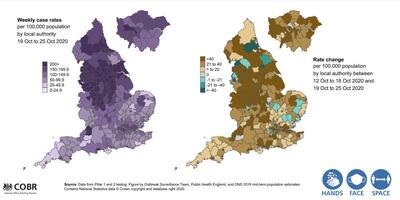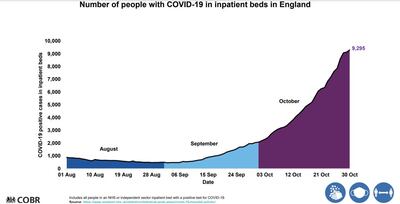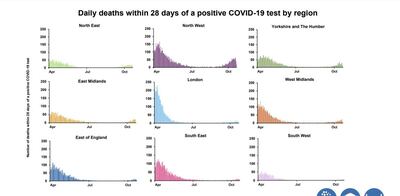"No responsible prime minister can ignore the message of those figures," said Boris Johnson as he announced that from this Thursday, England would be placed into a second national lockdown.
Two weeks ago the UK Prime Minister rejected calls for a circuit breaker saying "we are going to do it with the local, the regional approach that can drive down and will drive down the virus if it is properly implemented".
These charts, presented during the announcement of the lockdown, help to explain why Mr Johnson decided to embark on a rapid about-turn.
UK Chief Medical Officer Chris Whitty said that the R rate had been going up very rapidly, citing Office of National Statistics data which estimates about 50,0000 new cases a day, although he acknowledged that the rate would have been much higher "if people were not doing social distancing and other things".
These maps show how cases have been steadily increasing everywhere with a particular concentration in the north of England.
This chart emphasises the regionality of the case rate but Mr Whitty pointed out that cases were rising everywhere as justification for taking national action.
This heat map reaffirms the concentration of cases in the north but also shows that people aged 16 to 29 are the most likely age group to be infected.
NHS facing collapse without action
Of course it is not the escalating case rate alone that has persuaded Mr Johnson to get out his national padlock again - it is the potentially dire consequences of this increase.
This chart shows how hospital admissions have risen precipitously during October.
Boris Johnson's Chief Scientific Officer, Patrick Vallance, said hospitalisations could comfortably exceed those of the first wave, and cited NHS forecasts that show the extra available beds will be exceeded in mid-November - meaning that the NHS could effectively collapse in six weeks without action.
The warning wasn't lost on Mr Johnson who said that "the risk is for the first time in our lives, the NHS will not be there for us and our families".
The corollary of more hospitalisations is more deaths.
"Unless we act we could see deaths in this country running at several thousands a day," said the prime minister.
This chart shows that whilst Covid deaths are yet to come close the levels seen during the first wave of the virus, they are beginning to sneak up with the North West the most adversely affected.
Whether the second lockdown will be sufficient to stall the rise in fatalities remains to be seen. Mr Johnson did finish on a more sanguine note, saying he was "optimistic this will feel very different and better by spring".






